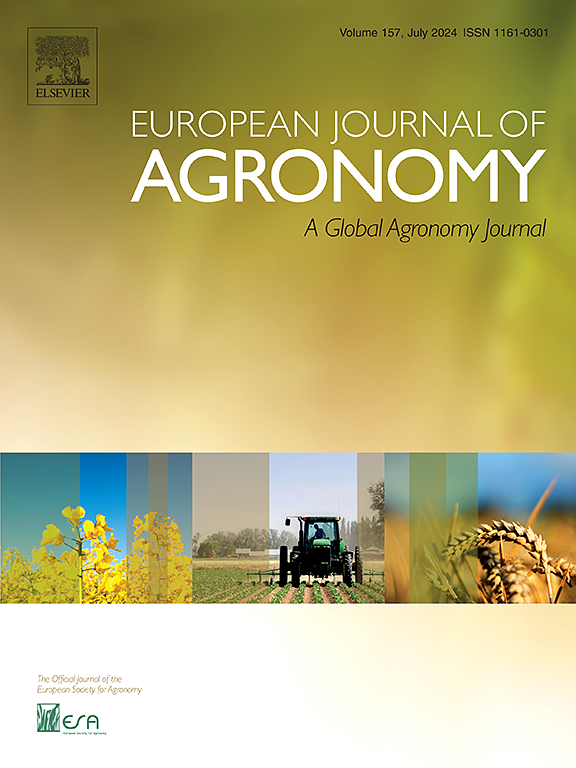Using UAV-based multispectral and RGB imagery to monitor above-ground biomass of oat-based diversified cropping
IF 4.5
1区 农林科学
Q1 AGRONOMY
引用次数: 0
Abstract
Timely access to crop above-ground biomass (AGB) information is crucial for estimating crop yields and managing water and fertilizer efficiently. Unmanned aerial vehicle (UAV) imagery offers promising avenues for AGB estimation due to its high efficiency and flexibility. However, the accuracy of these estimations can be influenced by various factors, including crop growth stages, the spectral resolution of UAV sensors, and flight altitudes. These factors need thorough investigation, especially in diversified cropping systems where crop diversity and growth stages interplay complexly, challenging the accuracy of AGB estimation. This study aims to estimate AGB of oats planted under different agricultural regimes—monoculture, crop rotation, and intercropping—at various growth stages (jointing, flowering, and grain-filling) and across all stages combined, using multispectral and RGB UAV images collected at different flight altitudes (25 m, 50 m, and 100 m). Three feature selection methods—maximal information coefficient (MIC), least absolute shrinkage and selection operator (LAS), and recursive feature elimination (RFE)—were tested. Four machine learning models—ridge regression (RR), multilayer perceptron (MLP), light gradient boosting machine (LGBM), and extreme gradient boosting (XGBoost)—were used for estimating AGB. Each feature selection method was combined with each machine learning model (e.g., MIC-RR, MIC-MLP, MIC-LGBM, MIC-XGBoost, LAS-RR) to evaluate their performance. Results revealed that the highest accuracy in AGB estimation was achieved with images acquired at a flight altitude of 25 m. The RFE-MLP model demonstrated superior results during the jointing stage (R² = 0.84, root mean squared error (RMSE) = 217.45 kg/ha, root mean squared logarithmic error (RMSLE) = 0.16, mean absolute percentage error (MAPE) = 4.15 %), the LAS-RR model excelled in the flowering stage (R² = 0.85, RMSE = 263.03 kg/ha, RMSLE = 0.05, MAPE = 14.44 %), and the RFE-XGBoost model was most effective during the grain-filling stage (R² = 0.68, RMSE = 865.03 kg/ha, RMSLE = 0.12, MAPE = 8.88 %). For cross-stage modelling, the RFE-MLP achieved remarkable results (R² = 0.93, RMSE = 680.44 kg/ha, RMSLE = 0.16, MAPE = 12.12 %). This study demonstrates the efficacy of combining feature selection methods with machine learning algorithms to enhance the accuracy of oat AGB estimations. The involvement of multiple cropping patterns enhances the generalizability of our findings, facilitating real-time and rapid monitoring of crop growth in future diversified cropping systems.
利用基于无人机的多光谱和 RGB 图像监测以燕麦为基础的多样化种植的地上生物量
及时获取作物地上生物量(AGB)信息对于估算作物产量、有效管理水肥至关重要。无人飞行器(UAV)图像因其高效性和灵活性,为估算作物地上生物量提供了广阔的前景。然而,这些估算的准确性会受到各种因素的影响,包括作物生长阶段、无人飞行器传感器的光谱分辨率和飞行高度。需要对这些因素进行深入研究,尤其是在作物多样性和生长阶段复杂交织的多样化种植系统中,这对 AGB 估测的准确性提出了挑战。本研究旨在利用在不同飞行高度(25 米、50 米和 100 米)采集的多光谱和 RGB 无人机图像,估算在不同农业制度(单作、轮作和间作)下种植的燕麦在不同生长阶段(拔节期、开花期和籽粒饱满期)以及所有阶段的 AGB 总量。测试了三种特征选择方法--最大信息系数 (MIC)、最小绝对收缩和选择算子 (LAS) 以及递归特征消除 (RFE)。四种机器学习模型--脊回归(RR)、多层感知器(MLP)、轻梯度提升机(LGBM)和极端梯度提升(XGBoost)--被用于估算 AGB。每种特征选择方法都与每种机器学习模型(如 MIC-RR、MIC-MLP、MIC-LGBM、MIC-XGBoost、LAS-RR)相结合,以评估它们的性能。结果显示,在飞行高度为 25 米时获取的图像的 AGB 估计精度最高。在接合阶段,RFE-MLP 模型显示出更优越的结果(R² = 0.84,均方根误差 (RMSE) = 217.45 千克/公顷,均方根对数误差 (RMSLE) = 0.16,平均绝对百分比误差 (MAPE) = 4.15 %),LAS-RR 模型在开花期表现出色(R² = 0.85,RMSE = 263.03 kg/ha,RMSLE = 0.05,MAPE = 14.44 %),RFE-XGBoost 模型在谷粒充实期最为有效(R² = 0.68,RMSE = 865.03 kg/ha,RMSLE = 0.12,MAPE = 8.88 %)。在跨阶段建模方面,RFE-MLP 取得了显著效果(R² = 0.93,RMSE = 680.44 kg/ha,RMSLE = 0.16,MAPE = 12.12 %)。这项研究表明,将特征选择方法与机器学习算法相结合可有效提高燕麦 AGB 估测的准确性。多种种植模式的参与增强了我们研究结果的可推广性,有助于在未来的多样化种植系统中实时、快速地监测作物生长情况。
本文章由计算机程序翻译,如有差异,请以英文原文为准。
求助全文
约1分钟内获得全文
求助全文
来源期刊

European Journal of Agronomy
农林科学-农艺学
CiteScore
8.30
自引率
7.70%
发文量
187
审稿时长
4.5 months
期刊介绍:
The European Journal of Agronomy, the official journal of the European Society for Agronomy, publishes original research papers reporting experimental and theoretical contributions to field-based agronomy and crop science. The journal will consider research at the field level for agricultural, horticultural and tree crops, that uses comprehensive and explanatory approaches. The EJA covers the following topics:
crop physiology
crop production and management including irrigation, fertilization and soil management
agroclimatology and modelling
plant-soil relationships
crop quality and post-harvest physiology
farming and cropping systems
agroecosystems and the environment
crop-weed interactions and management
organic farming
horticultural crops
papers from the European Society for Agronomy bi-annual meetings
In determining the suitability of submitted articles for publication, particular scrutiny is placed on the degree of novelty and significance of the research and the extent to which it adds to existing knowledge in agronomy.
 求助内容:
求助内容: 应助结果提醒方式:
应助结果提醒方式:


